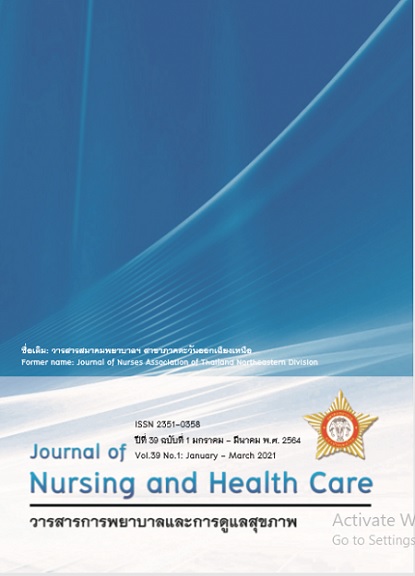ความต้องการด้านจิตวิญญาณของผู้ป่วยวัยรุ่นระยะวิกฤต
คำสำคัญ:
ความต้องการด้านจิตวิญญาณ, ผู้ป่วยวัยรุ่นระยะวิกฤตบทคัดย่อ
การวิจัยเชิงคุณภาพแบบบรรยายนี้ เพื่อศึกษาความต้องการด้านจิตวิญญาณของผู้ป่วยวัยรุ่นระยะวิกฤตตามกรอบแนวคิดความผาสุกด้านจิตวิญญาณขณะเกิดการเจ็บป่วยของโอไบรอัน กลุ่มตัวอย่างเลือกแบบเจาะจง เป็นผู้ป่วยวัยรุ่นอายุ12-18 ปี ที่เข้ารับการรักษาในหออภิบาลผู้ป่วยกุมารเวชกรรม โรงพยาบาลศรีนครินทร์ จำนวน 10 ราย โดยใช้แบบสัมภาษณ์ปลายเปิดที่มีค่าดัชนีความตรงเชิงเนื้อหาเท่ากับ 0.88 วิเคราะห์ข้อมูลเชิงปริมาณโดยใช้สถิติเชิงพรรณนา และใช้การวิเคราะห์เนื้อหาสำหรับข้อมูลเชิงคุณภาพผลการวิจัย พบว่า ความต้องการด้านจิตวิญญาณของผู้ป่วยวัยรุ่นระยะวิกฤต ประกอบด้วย 3 สาระสำคัญ คือ 1) ความเชื่อความศรัทธาต่อสิ่งที่มีคุณค่าและมีความหมายในชีวิต ต่อสิ่งศักดิ์สิทธิ์ และเรื่องบุญกรรม 2) การปฏิบัติกิจกรรมทางศาสนาหรือตามความเชื่อ ได้แก่ การแสดงออกถึงความเชื่อความศรัทธาต่อสิ่งศักดิ์สิทธิ์ การปฏิบัติกิจกรรมทางศาสนา และการบำเพ็ญประโยชน์ และ 3) ความอิ่มเอมใจในจิตวิญญาณ ได้แก่ การมีความหวัง มีกำลังใจ มีสิ่งศักดิ์สิทธิ์ช่วยคุ้มครองและมีศรัทธาในบุญกรรม ผลการวิจัยนี้ แสดงให้เห็นถึงความต้องการด้านจิตวิญาณของผู้ป่วยวัยรุ่นระยะวิกฤตที่พยาบาลควรตระหนักและให้ความสำคัญ โดยนำไปเป็นข้อมูลพื้นฐานในการประเมินและจัดกิจกรรมการพยาบาลที่เอื้อและตอบสนองต่อความต้องการด้านจิตวิญญาณของผู้ป่วยวัยรุ่นระยะวิกฤต
Downloads
เอกสารอ้างอิง
1. Reed PG. An emerging paradigm for the investigation of spirituality in nursing. Res Nurs Health 1992; 15(5): 349-57.
2. Gualdani S, Pegoli M. Spirituality in health care: The role of needs in critical care. Trends Anaest Crit Care 2014; 4(6): 175-77.
3. Johnston LB. Critical illness and spiritual faith in older adult: Survival factors/why spirituality matters. Paper presented at NACSW Convention 2014,
Annapolis, Maryland; 2014.
4. Koenig HG, King D, Carson V. Handbook of religion and health. New York: Oxford University; 2012.
5. Limumnoilap S. Critical illness and nursing care. In: Limumnoilap S, Tumnong C, editors, Critical care nursing. 7th ed (2nd revised edition). Khonkaen:
Klungnanawittaya; 2013. p. 1-27. (in Thai)
6. Johnson TD. Intensive Spiritual Care: A case study. Crit Care Nurse 2005; 25(6): 20-6.
7. O’Brien ME. Spirituality in nursing: Standing on holy ground. 5th ed. MA: Jones & Bartlett; 2014.
8. Monareng LV. Spiritual nursing care: A concept analysis. Curationis 2012; 35(1): E1-9.
9. Young C, Koopsen C. Spirituality, Health, and Healing: An integrative approach. 2nd ed. Sudbury, MA: Jones & Bartlett; 2011.
10. Kanokorn K. Spiritual well-being and spiritual needs in critically ill patients. Khonkaen: Khonkaen University; 2011. (in Thai)
11. Büssing A, Pilchowska I, Surzykiewicz J. Spiritual needs of Polish patients with chronic diseases. J Relig Health 2015; 54(5): 1524–42.
12. Hatamipour K, Rassouli M, Yaghmaie F. Zendedel K, Majd HA. Spiritual needs of cancer patients: A Qualitative study. Indian J Palliat Care 2015; 21(1): 61-7.
13. Bull A, Gillies M. (2007). Spiritual needs of children with complex healthcare needs in hospital. Paediatr Nurs 2007; 19(9): 34-8.
14. Shek DTL. Spirituality as a positive youth development construct: A conceptual review. The Scientific World Journal 2012; Article ID 458953: 8 pages.
15. Wiener L, McConnell DG, Latella L, Ludi E. Cultural and religious considerations in pediatric palliative care. Palliat Support Care 2013; 11(1): 47-67.
16. Piaget J. The origins of intelligence in Children. London: Routledge & Kegan Paul; 1953.
17. Herth K. Abbreviated instrument to measure hope: development and psychometric evaluation. J AdvNurs 1992; 17(10): 1251-59.
18. Miller JF. Hope: A construct central to nursing. Nurs Forum 1992; 42(1): 12-19.
19. Kaewchoei N. Effects of Montessori-based activities on grip strength and hope of the stroke patients. Master of Science program in mental health
(Psychiatric), Graduate school, Chulalongkorn University; 2009. (in Thai)
20. Yousefi H, Abedi HA. Spiritual care in hospitalized patients. Iran J Nurs Midwifery Res 2011; 16(1), 125-32.
21. Duangwises N. Anthropological concepts and the studies of animistic beliefs in Thai society. Journal of Humanities and Social Sciences Burapha University
2017; 25(47): 173-97. (in Thai)
22. National Statistical Office. Survey of social and cultural conditions 2011. [Internet]. 2012 [cited 2016 July 23rd]. Available from:
http://service.nso.go.th/nso/nsopublish/pubs/sns/5510-12.pdf (in Thai)
23. Prabnok P. Buddhist Dharma in Isan Literature. Humanities and Social Sciences 2014; 31(2): 55-78. (in Thai)



